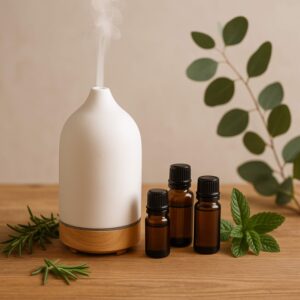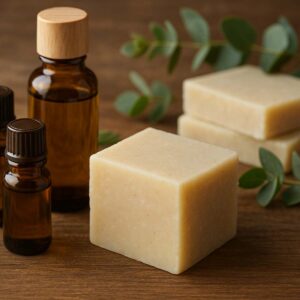Solvent Extract vs Supercritical CO₂ Extract — Which Is Better for Essential Oils and Oleoresins?
Solvent Extract vs Supercritical CO₂ Extract. The art and science of extracting essential oils and oleoresins lies at the very heart of the natural products industry. Whether you are formulating fine perfumes, therapeutic aromatherapy blends, food flavors, or nutraceuticals, the extraction method you choose defines the quality, purity, and aroma of the final product. Behind every drop of essential oil or oleoresin lies a carefully engineered process designed to separate volatile and non-volatile compounds from plant materials and the way this process is carried out directly influences not just the product’s composition, but also its cost, safety, and market value.
Why Extraction Method Matters
Each plant species contains a complex array of natural compounds — aromatic terpenes, phenols, esters, waxes, pigments, and resins. These compounds are delicate and highly sensitive to heat, pressure, and solvent exposure. A method that’s too harsh can destroy the very molecules responsible for an oil’s healing properties or alter its fragrance profile beyond recognition. Conversely, a method that’s too gentle might yield very little extract, making the process uneconomical on a commercial scale.
This is why extraction technology is not just a technical step — it’s a strategic decision that balances chemistry, cost, and desired end use. The same botanical source can produce remarkably different results depending on how it’s processed. For instance, peppermint oil obtained through traditional steam distillation will have a sharper, more volatile top note, while the same plant extracted through supercritical CO₂ may exhibit deeper, smoother, and more complex undertones.
The Impact on Purity, Yield, and Aroma Profile
Three key metrics define extraction quality in the essential oil and oleoresin sector:
- Purity – Refers to the absence of contaminants or residues. Food and pharmaceutical grade applications require extremely clean extracts. While some methods risk leaving traces of solvents, others, such as supercritical CO₂, yield completely solvent-free products that meet the strictest international standards.
- Yield – The amount of oil or resin recovered from raw material. High yield improves profitability but may compromise purity or aroma if excessive heat or aggressive solvents are used. Advanced extraction methods allow producers to optimize yield without sacrificing quality.
- Aroma Profile – The sensory “fingerprint” of the extract. In perfumery, this is everything. Each extraction method influences how aromatic compounds are preserved, altered, or lost. Natural perfumers, for example, often prefer solvent extracts (absolutes) for their full, rich scent, while therapeutic producers may prefer CO₂ extracts for their truer-to-nature representation of the plant.
Ultimately, these variables—purity, yield, and aroma—define whether an extract will be used in a pharmaceutical-grade product, a fine perfume, or an industrial fragrance.
Two Leading Modern Methods: Solvent Extraction and Supercritical CO₂ Extraction
While traditional techniques such as steam distillation and cold pressing remain important, modern industries increasingly rely on Solvent Extraction and Supercritical CO₂ Extraction for higher precision, consistency, and versatility. Both are capable of extracting a wide range of aromatic and bioactive compounds, but they differ fundamentally in mechanism and outcome.
Solvent Extraction uses organic solvents like hexane or ethanol to dissolve plant compounds, producing concentrated “concretes” and “absolutes.” This method excels with delicate flowers such as jasmine or rose, which cannot tolerate the high heat of distillation. However, solvent residues and environmental concerns are its main limitations.
Supercritical CO₂ Extraction, on the other hand, employs carbon dioxide under high pressure and controlled temperature. In its supercritical state, CO₂ behaves as both a gas and a liquid, selectively extracting desired components without leaving any residue. It is clean, tunable, and sustainable — representing the future of natural extraction technology.
What Is Solvent Extraction?
Solvent extraction is one of the oldest yet most versatile methods used in the production of essential oils, oleoresins, and natural aromatic compounds. It is particularly valued for its ability to extract delicate, heat-sensitive materials that would otherwise lose their fragrance, color, or chemical integrity under high temperatures.
Unlike steam distillation—which relies on heat to volatilize compounds—solvent extraction uses organic solvents to dissolve both volatile and non-volatile components from plant material. The result is a highly aromatic, full-spectrum product known as a concrete or, after further refinement, an absolute.
Advantages of Solvent Extraction
- Ideal for Delicate Botanicals: Flowers like jasmine, tuberose, and mimosa cannot tolerate the high heat of steam distillation. Solvent extraction preserves their complete fragrance profile, including subtle notes lost in other methods.
- High Yield: Because solvents can dissolve both volatile and semi-volatile compounds, they often produce a higher total yield than distillation.
- Rich Aroma: The resulting concretes and absolutes have deep, full-bodied aromas that closely match the natural scent of the plant. This makes them highly prized by perfumers.
Limitations and Concerns
While solvent extraction remains an indispensable method in the natural products industry, it does come with drawbacks:
- Residual Solvents: Trace amounts of hexane or other solvents may remain in the final product if not carefully removed. For this reason, food-grade and pharmaceutical industries often avoid solvent-extracted materials unless certified residue-free.
- Environmental & Safety Issues: Organic solvents are flammable and pose environmental hazards if not handled properly. Recovery and recycling systems are therefore crucial in industrial setups.
- Not Ideal for Therapeutic Use: While solvent-extracted oils may smell stronger, they are not considered suitable for aromatherapy or topical medicinal use because of potential solvent traces.
Common Applications
Despite its limitations, solvent extraction continues to play a major role in several industries:
- Perfumery: Solvent extraction produces absolutes, which are essential for luxury perfumes due to their authentic and long-lasting fragrance.
- Flavoring & Food Industry: Used for producing oleoresins and natural flavor extracts, such as vanilla absolute, paprika oleoresin, or coffee extract.
- Cosmetics: Found in premium skincare and cosmetic formulations for its strong, long-lasting scent and emollient properties.
- Industrial Use: Employed where solvent residues are not a concern—such as in detergents, incense, and air fresheners.
Solvent extraction remains a high-yield, aroma-rich, and cost-effective technique that bridges traditional craftsmanship and modern production. However, growing consumer awareness and regulatory focus on “clean-label” products are gradually driving industries toward safer, greener alternatives—most notably Supercritical CO₂ Extraction, which we’ll explore next.
What Is Supercritical CO₂ Extraction?
Supercritical CO₂ Extraction represents the most advanced and environmentally responsible technology currently used in the essential-oil and oleoresin industries. Unlike traditional solvent extraction, which relies on chemical solvents, this method employs carbon dioxide (CO₂) under specific conditions of pressure and temperature. At these conditions, CO₂ behaves as both a gas and a liquid — a “supercritical” state — allowing it to act as a clean, tunable solvent that extracts aromatic and bioactive compounds with exceptional precision and purity.
This process has revolutionized natural-product manufacturing because it delivers solvent-free, residue-free extracts that preserve the full chemical integrity of the plant. It has become the gold standard for industries demanding uncompromising quality, including food, pharmaceuticals, cosmetics, nutraceuticals, and high-end aromatherapy.
Advantages of Supercritical CO₂ Extraction
- Solvent Free Purity – No chemical residues; meets food- and pharmaceutical-grade purity standards.
- Low-Temperature Operation – Protects delicate aromatic compounds that degrade under heat.
- Selective Extraction – Adjustable parameters allow extraction of target compounds only — for example, flavor components without waxes.
- Environmentally Sustainable – CO₂ is non-toxic, non-flammable, and fully recyclable, offering a green alternative to petroleum-based solvents.
- True to Nature Aroma – The resulting extract mirrors the plant’s natural fragrance and chemical balance, ideal for therapeutic and cosmetic use.
Limitations and Considerations
- High Initial Investment – Equipment costs are significantly higher than for solvent extraction.
- Technical Expertise Required – Operators must understand pressure dynamics, thermodynamics, and CO₂ phase behavior.
- Processing Time – Precision control can extend cycle times compared to simple solvent soaking.
- Yield Optimization – Because CO₂ selectivity can be tuned, achieving both purity and high yield often requires multiple experimental runs.
Industrial and Commercial Applications
- Food & Beverage Industry → Flavor and aroma extraction for coffee, tea, hops, and vanilla with no residual solvents.
- Perfume Industry → Creation of CO₂ absolutes, offering the richness of traditional absolutes with modern purity standards.
Supercritical CO₂ Extraction combines scientific precision with environmental responsibility. By using CO₂ as a clean, tunable solvent, it eliminates the drawbacks of chemical extraction while producing higher-quality, more stable, and more natural-smelling oils. For producers seeking to meet modern consumer expectations for purity, sustainability, and safety, Supercritical CO₂ is the future of essential-oil and oleoresin extraction technology.
Key Differences Between Solvent Extraction and Supercritical CO₂ Extraction
While both Solvent Extraction and Supercritical CO₂ Extraction aim to separate valuable aromatic and bioactive compounds from plant material, their principles, purity levels, and industrial outcomes differ dramatically. These differences determine how each extract is used — whether in high-end perfumery, pharmaceuticals, food processing, or industrial fragrances.
Understanding these distinctions is crucial for formulators, manufacturers, and buyers because the extraction method directly affects safety, aroma authenticity, shelf life, and regulatory compliance.
Let’s explore their core differences in greater depth.
1. Extraction Mechanism
Solvent Extraction relies on organic solvents such as hexane, ethanol, or petroleum ether to dissolve essential and non-volatile compounds from plant matter. It is a chemical process that requires later separation of the solvent from the extract through evaporation and purification.
Supercritical CO₂ Extraction, on the other hand, uses carbon dioxide under high pressure and moderate temperature in its “supercritical” phase — where it behaves as both a gas and liquid. It physically solubilizes plant compounds without introducing any foreign chemicals, producing residue-free extracts.
In short, one uses chemical dissolution, while the other uses physical solvation — a key difference that defines their downstream purity.
2. Purity and Residual Solvents
Purity is the defining parameter in modern natural extraction.
Solvent extraction can leave trace residues of hexane or alcohol, which, although often within legal limits, can be undesirable in pharmaceutical or food-grade applications.
Supercritical CO₂ extraction leaves absolutely no residue, since CO₂ naturally returns to the atmosphere after depressurization. This makes it the preferred choice for clean-label and organic-certified industries.
Verdict: Supercritical CO₂ wins in purity, safety, and compliance with global regulatory standards (GRAS, ISO, and IFRA).
3. Aroma and Chemical Profile
The aroma authenticity of the extract is another key differentiator.
Solvent extraction captures a richer, more rounded fragrance, including waxes and heavier compounds, which makes it popular among perfumers seeking depth and fixative qualities.
Supercritical CO₂ extraction, however, produces a truer-to-nature aroma that closely mirrors the living plant. The controlled temperature ensures volatile compounds are not degraded, preserving delicate top notes and bioactive molecules.
Verdict: Solvent extraction yields complexity; CO₂ extraction yields precision and natural purity.
4. Yield and Efficiency
Solvent extraction typically yields more total extract, since solvents dissolve both essential oils and other plant constituents such as pigments and waxes. However, not all of this yield is usable oil — much must be refined out later.
Supercritical CO₂ extraction can be fine-tuned to target specific compounds, achieving high efficiency for select fractions (e.g., terpenes, oleoresins, antioxidants) with minimal waste.
Verdict: Solvent extraction may offer higher crude yield, but CO₂ extraction offers smarter yield — purer and more customizable.
5. Safety, Sustainability, and Environmental Impact
Solvent extraction involves flammable, toxic solvents, which pose safety risks and environmental burdens if not properly handled or recovered. Disposal of solvent waste is tightly regulated.
CO₂ extraction, by contrast, uses non-toxic, non-flammable carbon dioxide in a closed-loop system. The gas is fully recyclable and leaves no waste, making it a green and sustainable technology favored by eco-conscious manufacturers.
Verdict: CO₂ extraction is far more environmentally responsible and worker-safe.
6. Cost and Accessibility
Solvent Extraction requires relatively simple equipment — making it affordable and practical for small-scale producers, especially in developing regions.
Supercritical CO₂ Extraction demands a high initial investment in specialized high-pressure systems and technical expertise. However, over time, its low waste, solvent recovery, and product quality can offset the higher startup costs.
Verdict: Solvent extraction wins on setup cost; CO₂ extraction wins on long-term ROI and quality consistency.
7. Regulatory Acceptance and Industry Preference
In industries governed by strict safety and purity standards — such as food, pharmaceuticals, and cosmetics — solvent-based extracts are often viewed with caution. Increasingly, multinational brands and regulators prefer CO₂ extracts because they eliminate solvent-related compliance risks and align with consumer demand for clean, natural, and chemical-free products.
Verdict: CO₂ extraction leads the future of high-standard natural ingredient manufacturing.
Disclaimer:
The health or medical information on this article / page is for educational and informational purposes only and not intended to diagnose, treat, or prevent any disease. Please consult a healthcare professional before using any essential oils, oleoresin or extracts.




